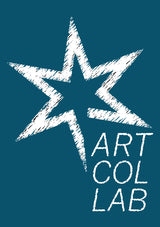

-
Interview with Patrizia Sandretto Re Rebaundengo.
Ana Elisa Egreja creates works that move on a thin line between balance and chaos, sometimes deliciously calm and quiet due to the lack of human presence, sometimes strangely delirious and kitsch. The artist creates her interiors from life, in scale one to one, and then depicts them on canvas. To get to the heart of the artist's lyrical and fascinating imagination and her suspended atmospheres, I asked her to tell us about her creative process.
PSRR: Could you tell us about your work and your artistic research? What is the creative process through which you give life to your works?
AEE: I have been working with paint for over 15 years; my way of painting has changed, but my thematic research has remained very linear, presenting still lifes and interior painting in its most varied forms, including food, utensils, furniture, plates, and fabrics. I seek inspiration in everyday life, and objects are my characters to create new utopian worlds through painting.
PSRR: Looking at your works, there is a feeling of playfulness, combined with the wonder of seeing the world through a different lens for the first time. It makes me think of a kind of second childhood. Where do you find inspiration to create these scenes?
AEE: I believe it is because we – rightly – relate freedom and fantasy with the free mind of the child, but many authors of Magic Realism (a literary movement of great importance in Latin America) have used and still use fantastic images as rhetorical figures, metaphors and other linguistic resources that confuse the notion of time through surreal images. Illustrated as part of reality, they denounce absurd situations such as dictatorship, for example. Inspired by these authors, I also try to tell stories, but, rather than through words, with images and symbols in the painting.
PSRR: How and how much does Brazil influence your work?
AEE: A lot! I studied Fine Arts, so my work is full of references to European schools, mainly to Dutch painting – both for the realistic technique and for the domestic theme – but my interpretation of these concepts is completely influenced by the "Brazilian spirit", which is full of conflicts. True, the image of Brazil that has been exported sees a tropical place with lush landscapes and colorful areas, but we also feel sadness and injustice in continental proportions. Brazil is a colonized and exploited Country that today is more polarized than ever, to the point of electing a terrible person like the current president. We are the country of improvisation, there is even an artistic term, "Gambiarra aesthetic" (in English jerry-rigged); it is so latent that many Brazilian artists mention it in some way. All these questions mix in my head and in my paintings all the time.
PSRR: Architecture and interior design seem to inspire your work a lot, where does this call come from? Which designers or architects do you admire the most?
AEE: I love all kinds of architecture! I am a big fan of Frank Lloyd Wright. Brazilian modernism is something very present around here and I am very proud of it: Artacho Jurado, Rino Levi, Lina bo Bardi, Oscar Niemeyer... In my last solo exhibition here in São Paulo "Fazer Realidade"/ "Making Reality", at the Leme Gallery – designed by another great icon, Paulo Mendes da Rocha – I represented plenty of my favorite architects. Now I am just back from Mexico; there I visited several houses in Barragan and cannot wait to paint them!
I could not not mention the architecture and vernacular art made by those who have not studied, but which retains an aesthetic sense that seems magical; after all, no one knows where it comes from. This concept is what inspired the entire "Colors" series – presented by Artuner in 2020. (https://www.artuner.com/curations/colors-ana-elisa-egreja/)
PSRR: In paintings in which you depict dishes, you can make us feel the texture and smell of food; are you passionate about cooking? Do you create the design of the plates, or do you paint from pre-existing models?
AEE: I love cooking and I am also enthusiastic about the still life genre, so I would say a combination of both! When I enter a museum, I immediately look for still life art; it is a genre painted by all the great masters of the past – it is an exercise in important and formal modernism, and it is also popular! Through still life, artists were always depicting their domestic objects, and therefore their lives and customs through the centuries.
The dishes I painted are known as "Flow Blue". They are English and date back to the 19th century; they were originally inspired by Chinese models but produced industrially; this process generated the blurs that then gave the series its name. There are plenty, here, to collect these dishes, and I already had their photos in my folder of reference images "things of home". I started the series during pandemic, creating the compositions with the food I cooked for my children. Each round canvas was handmade and has the exact size of each plate, which created a "trompe l'oeil" effect that I found interesting – as if the plate had slipped out of the painting and become part of the real world again!
PSRR: What did you think about the idea of collaborating with artists from different sectors? How does it feel to see your art expressed through new formats?
AEE: Loved it as an idea! It is the first time I have done a collaboration like this, and I hope it's the first of many others... I have always wanted to create works also with the fashion industry. For this project, I was inspired by the tradition of Flow Blue plates to create my model - and so I created my Flow Blue dish with tropical pink flamingos!
